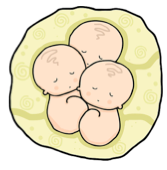This site encourages inductive learning of grammar. To get a sense of what such learning is like, go through this short lesson by Dr. Myriam Met, in a made-up language. By the time you get to slide 8, can you match the text with the images? We’re hoping you can!

To reinforce Chinese grammar inductively, we can ask-and-answer questions, choose from multiple choices, or tell a story, as in the following activities.
• Sometime Chinese native speakers don’t bother to distinguish among 的、得、and 地 anymore, but if you’d like to reinforce student understanding of these particles, try this multiple guess activity.

• A term or bit of grammar doesn’t have to be tricky to warrant some attention. How to use 别 in Chinese is pretty straightforward; it’s the same word order as “don’t” in commands. My students were asked compose one illustration the use of别 for homework, and this is what they came up with. The whole class enjoyed reading the mostly humorous examples, and everyone learned something.

• Are your students constantly putting the placeword in a sentence in the wrong place? Have them tell each other (or the whole class) more about their lives by answering the questions on the slides in the file below, to help them get the placeword placement right.

• Do you have a hard time getting students to understand the usages of 就 versus 才? Rotate around the class having each student answer the question on each slide based on their own lives, and see if that helps.

• In English, descriptions of a noun go AFTER the noun (“the dress THAT I BOUGHT YESTERDAY”), but in Chinese they go BEFORE the noun (“我昨天买的那件衣服“), which, not surprisingly, is confusing to students. Read the following silly story together to drum in the Chinese sentence order.

• Resultative verb compounds are unique to Chinese. No wonder students struggle with them. Help them out by having each student in class answer each of the humorous questions on the slides below; by the time have laughed their way through the exercise, they will have heard a heap of examples of resultative verbs. The larger your class, the more examples they will hear!

• This exercise on one page circulated on Pinterest focuses on some key location terms.
• The handy 把-structure is confusing to students until they build understanding through sufficient exposure. The humorous examples provided here might help.

